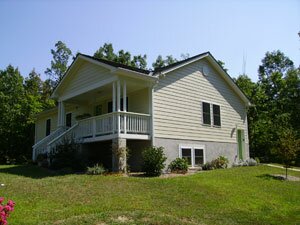REAL ESTATE- ON THE BLOCK- Do your part: Clean living and clear conscience in Esmont

PHOTO BY PETER M. J. GROSS
ADDRESS: 2856 Camp Spring Road
NEIGHBORHOOD: Esmont
ASKING: $219,900
ASSESSMENT: $179,500
YEAR BUILT: 2004
SIZE: 1,176 fin. sq. ft.
LAND: 4.98 acres
CURB APPEAL: 7.5 out of 10
LISTED BY: Harrison Grubbs, Summit Realty Company, 434-817-4040
"Eat right, exercise, die anyway." It's a quip from a bumper sticker, but it raises a valid question: What immediate luxuries should we sacrifice for long-term sustainability, especially when nothing is permanent? When discussing the health of the planet, some advocates demand that we forgo our more pleasurable excesses, while others want us to "think green" while upholding the standard of living we like so much. This week's Esmont house is designed for those "others."
The house is made entirely with insulated concrete form (ICF) walls, by pouring concrete into Styrofoam molds that are left in the finished house to provide insulation. Critics claim that ICF constructions are not truly green, as cement production has been accused of being responsible for 5 percent of worldwide carbon emissions, compared to growing trees for timber constructions, which actively absorbs carbon.
However, ICF proponents point out that the efficient insulation means less energy spent on heating and cooling, and that the savings spread across the long life of the structures more than offset the production costs. For the homeowner, the very thick walls mean lower heating and cooling bills and no external wood touching the ground to tempt termites.
Other green features of the house are less controversial, such as sun tubes in the hallway and bathroom that amplify natural light with mirrors to reduce the need for electric lighting. Also of note are features like a rainwater collection system– all the gutters drain into a 2,000 gallon holding tank that can supply toilets and garden hoses– and the eco-shake shingles of recycled cellulose and reinforced vinyl. Effective but less exotic are the energy-efficient double-hung windows.
Aside from its deep window ledges, nothing visually separates the house from its less green contemporaries. The floor plan includes a master bedroom at the back, with a bathroom with ceramic tile and a built-in storage area. The two remaining bedrooms share a bathroom off the main hall, and in the front of the house an open floor plan has the kitchen, dining, and living areas in the same space.
Stairs to the basement take up some of the floor space, making the living and dining areas overlap slightly for a cozier feel. The kitchen, however, is set apart by a breakfast bar, and is very well lit by halogen track lights, under-cabinet lights, and additional recessed lighting.
Since adding on to the sides of the house would involve punching through several inches of concrete, ambitious renovators would best turn to the unfinished basement, which already has some drywall up and a roughed-in third bathroom. Although it's currently one big open space, arranging rooms could be tricky (but not impossible), as one would have to work around the air system and pumps that control the well and the rainwater storage tank.
The tank itself is discreetly buried in the front yard, which is essentially a multi-acred clearing. The remainder of the five-acre lot has been maintained as woodland, with owner-added walking and running trails. The land is also removed from public roads, an arrangement granting privacy in exchange for increased responsibility. Since Camp Spring Road is not a County road, residents share maintenance responsibilities like cutting grass and keeping the drainage ditches clear, but that should pose no problems to someone who is already thinking about the planet.
These days, more developers employ environmentally friendly methods to build houses, catering to conservation-minded individuals ranging from die-hards who filter and drink their own urine to caring but less dedicated souls who turn off lights and keep the thermostat at reasonable temps summer and winter. (There are, of course, also don't-cares who water their lawn for four hours during the drought, but they're not reading this column.) Ultimately, this may be a good house for those who want to do their part for the planet but don't want to break a sweat in the effort.
Each week, a brave local seller invites the Hook to provide an impartial, warts-and-all look at their real estate listing. E-mail yours today!


PHOTOS BY PETER M. J. GROSS
#